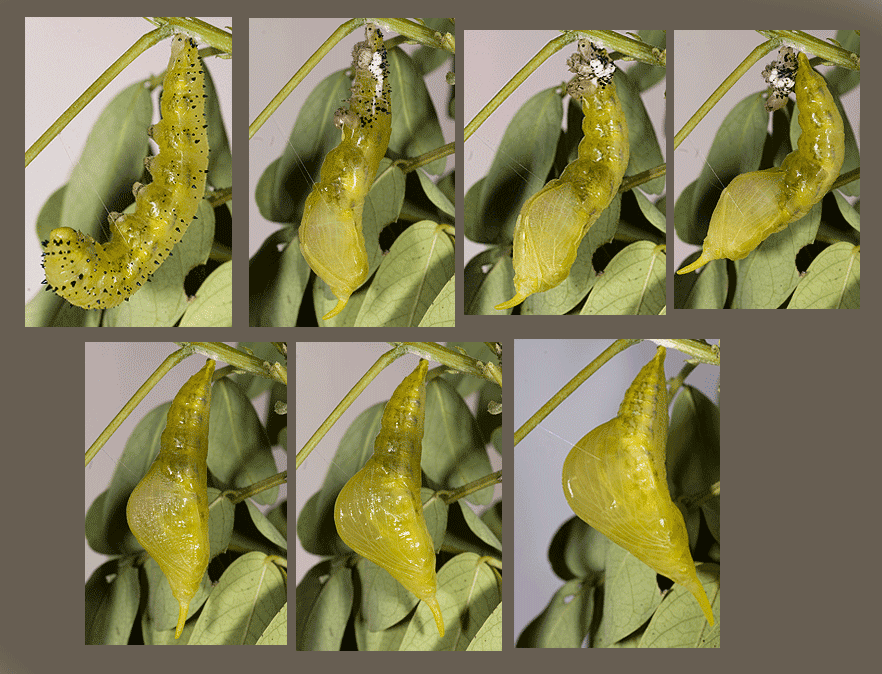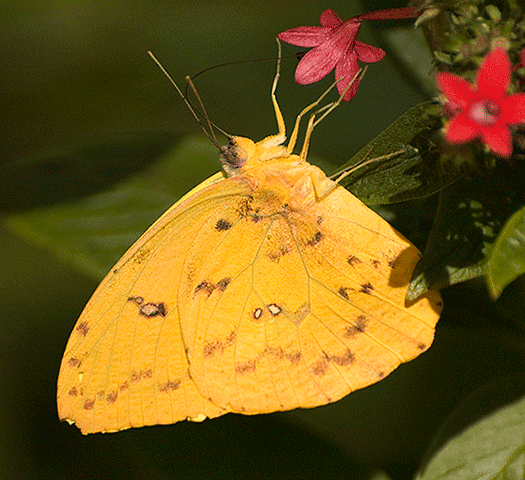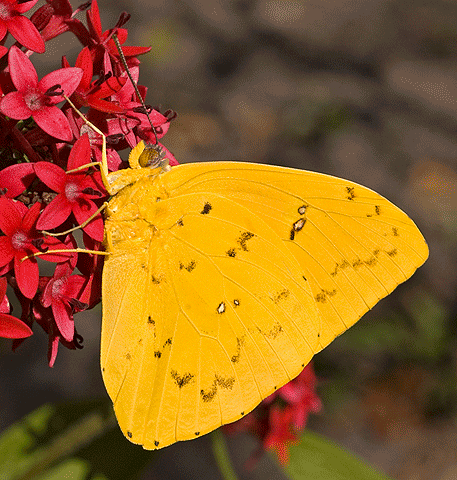Orange-barred Sulphur Butterfly
Phoebis philea
Orange-barred Sulphur Butterfly
Phoebis philea
Photographs by Susan Leach Snyder
The orange-barred sulphur female lays her white eggs singly on one of several species of shrubs in the genus Cassia. Once it hatches from the egg, the caterpillar has a voracious appetite for the Cassia leaves.
As it continues eating, it molts, and changes form.
Shown at left, the molting caterpillar leaves behind the skin (exoskeleton) of the previous instar. (An instar is a developmental stage).
The two photographs at left show a caterpillar using the bristles on its hind appendages (prolegs) to hold onto vegetation, while it uses its three pair of walking legs to grasp the leaf near its mouth.
In the series of photographs below, the caterpillar climbed to a plant stem, secured its posterior end to the plant with silk, spun a silk thread to create a girdle from which to hang, and transformed into a chrysalis. Note: The second through the fourth photos in the series show the skin of the caterpillar being pushed up toward the posterior end of the chrysalis. Just after the fourth photograph was taken, the skin fell to the ground. Note how the shape of the chrysalis transforms and how the head orientation changes throughout this sequence of photos. [The head is the pointed end at the bottom of each photograph.] In photo 7, the chrysalis has completed its external transformation. The process took 2 hours and 20 minutes.

As shown below in the left photograph, fourteen days later, the skin of the chrysalis became transparent and the orange on the top forewings of the male adult were visible. The following day, sometime between 3:00 AM and 6:00 AM, the adult emerged.
The wingspan of an Orange-barred Sulphur adult can be 65-80 mm. It is their bright yellow color (the color of butter) that gives butterflies their name.
The male and female have distinctive differences in their coloration. Males are a bright yellow with orange patches across both the forewings and hind wings. Females range in color from white to yellow. Most females have a reddish-orange border on the hind wings and a border of black spots along both their forewings and hind wings. Typically, females have more dark markings on their underwings than do males. Orange-barred Sulphur butterflies are often seen in the Lagoon Trail gardens, flitting from plant to plant, but they rarely land with their wings open. Shown below, both the female on the left and the male on the right were on red pentas flowers. Note that the female's proboscis (constructed of two feeding tubes) is fully extended into the pistil of a flower.


The orange-barred sulphur is not native to Florida, but it has been established in Florida since the 1930s.
___________________________________
Links:
Index to Butterfly and Moth Visitors to the Conservancy Ecotone Trail
Index To Photographs of Plants in the Gardens
Conservancy of Southwest Florida Ecotone Home Page
Conservancy of Southwest Florida Home Page.
Please report errors to Susan Snyder at susanleachsnyder@gmail.com